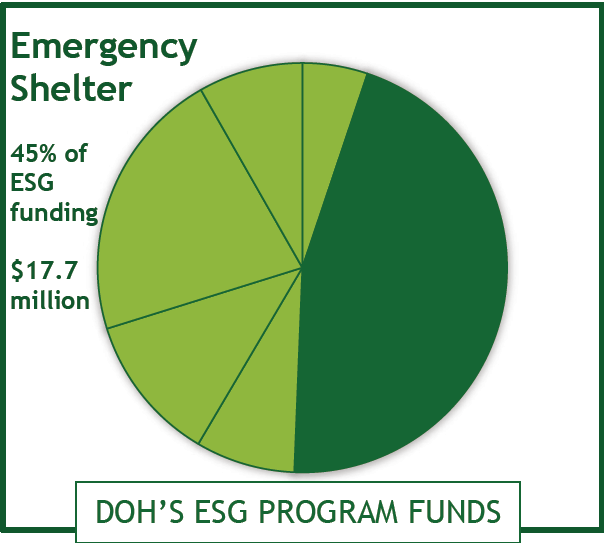Leading with Lived Expertise: Emergency Shelter
Overview of Emergency Shelters
Emergency shelters include any facility whose primary purpose is to provide a temporary shelter for people experiencing homelessness in general or for specific populations. Emergency shelters do not require occupants to sign leases or occupancy agreements. Additionally, they offer non-time-limited access to life-saving shelter that ends (ideally) when individuals and families exit to permanent housing. While emergency shelters will be different across Colorado communities, they should all focus on 1) housing those residing in the shelter as quickly as possible without requiring preconditions and with housing stability plans as needed, 2) training staff and/or volunteers to create safe shelters for all, and 3) minimizing barriers (both physical and behavioral) that limit entrance in shelter.
ESG Currently Supports Emergency Shelters by Paying for:
- Essential services including case management, child care, education, employment assistance and job training, outpatient health, legal services, life skills training, mental health, substance use treatment, transportation, and services for special populations including youth.
- Shelter operations including rent, maintenance, repair, security, fuel, equipment, insurance, utilities, food, or supplies necessary for the operation of the emergency shelter.
- Hotel or motel vouchers where no appropriate emergency shelter is available.
- Certain types of renovation for eligible buildings.
Recommendations for DOH’S ESG Emergency Shelter Programs
Emergency shelters save lives, but many people choose not to enter shelters for various reasons. Some individuals have experienced traumatic assaults in shelters. Others cannot meet unrealistic shelter expectations, ranging from the ability to walk down a flight of stairs to being asked to give up a pet in order to access services. Many cannot live in congregate settings with a high number of other individuals, cannot manage their possessions if shelters are not open during the day, and/or have work schedules that conflict with shelter curfews. Still others cannot access shelter, even if they want to, due to lack of shelter space, as the demand for shelter beds often far exceeds availability. Of these concerns, safety in emergency shelter safety is the top concern of the LEAG. Effective shelter models must meet people where they are, create inclusive and affirming spaces for healing and trust, and address mental or physical barriers that keep people from attaining and maintaining permanent housing. The second priority for the LEAG is that shelters actively work to end homelessness for those residing in their programs by focusing on housing connections and tailored housing supports. The goal of shelters is to rehouse people, not to “fix” them so that they are “deserving” of housing. This specialized work requires a well-trained and adequately staffed workforce that understands how to keep people safe, physically, emotionally, and mentally.
The “3 E’s” for Creating Equity in Emergency Shelter
Empower
- Shelter work is a great opportunity for people with lived experience to explore a career in the homeless response system. Create peer support programs in emergency shelters.
- Shelters often have a list of rules that is overwhelming or unrealistic. Shelter providers need rules to create safe environments, but providers should create and regularly revisit these behavior expectations in tandem with those living at shelters. Instead of imposing an ever-increasing list of rules based on specific situations or stereotypes, improve staff training in de-escalation, mental health first–aid and crisis response.
- Shelter staff are onsite to serve those living in shelters. Therefore, staff accountability should come from the shelter guests and shelter leadership should leverage anonymous guest feedback as a core part of staff evaluations.
- Many shelter providers collect feedback from guests, but may not use that feedback to change operations. Shelters should always be able to point to specific policies that have recently changed as a direct result of guest feedback.
- Person-centered services are an evidence-based practice. Shelters should only offer services that those living in the shelter say they need in order to address housing instability.
- Shelters should not have a set amount of time that individuals can use their services. Resident stability should dictate when and how they leave shelter programs.
Engage
- Emergency shelters provide a life-saving service by keeping people in habitable environments when they lose their housing. Most often, however, people will need more support than just “three hots and a cot” (three hot meals a day and a place to sleep). Shelters should leverage local partners to offer services onsite rather than expending their limited resources duplicating services or asking guests to go to other service locations. Programs that offer healthcare, access to benefits, mental health care, education, and any other service that could help someone regain permanent housing should be brought to the shelter and offered to guests.
- Shelter program design should include input from experts in diverse populations, including those with lived experience. Has your shelter been verified as a safe space for LGBTQ+ populations? Are programs able to accommodate individuals with physical or developmental disabilities? If not, providers must leverage lived expertise to create safe and accessible spaces. This includes staff training as well.
- Shelters are not expected to serve every type of guest, but targeting niche populations should be justified by a lack of shelter for those populations locally.
- If shelters do not have the capacity to manage housing programs, they should have direct relationships with partners who do in order to provide effective referrals.
Evaluate
- Emergency shelters exist because people lose their housing. They should, therefore, be evaluated on their ability to re-house people.
- Most members of the LEAG had a personal story about not accessing shelter because they did not feel safe. Shelters must create data feedback loops so that guests know any attacks or assaults will be taken seriously and addressed by staff. This must incorporate assurances that those who report will not be retaliated against.
- Tracking how many partner agencies are onsite offering services, the use of those services by guests, and the most effective time for offering services will provide data that ensures shelters are providing the right services at the right time.
- In tandem with #3, shelters should track what gaps exist in local services and work to fill those gaps as needed by shelter guests to increase housing outcomes.
- Shelters should track who is not able to access shelter services, why, and what would be needed to address those barriers. This may include physical design, program rules, etc.
- Shelters must track how many staff complaints happen each year, which staff have multiple complaints, and any plans to address these concerns.
- Tracking how many guests are referred to coordinated entry systems and how quickly are those housing referrals made once guests enter shelter ensures s focus on housing.
- Shelters should track how long people are able to stay in housing once they leave the shelter.
More Impressions from the LEAG
Emergency shelters provide life-saving shelter and housing-focused services first, but can also provide wrap-around services to address client-driven needs aimed at housing stability.
Few, if any, housed people would choose living in a congregate shelter over their own, private and safe space. They should not be surprised, then, when individuals without housing make the same choice. Therefore, those who are working in the homeless response system have a responsibility to make shelters safe and available to any individual in their community who is experiencing homelessness. Shelters must keep the exit to permanent housing at the forefront of all conversations with shelter guests, and work through housing plans on a case-by-case basis to ensure they can provide the person-centered support required to achieve that goal quickly.
"Two priorities that communities should work on as they address homelessness are equity and safety. These priorities go hand in hand as the members of our community most affected by homelessness are often those most vulnerable to the greatest dangers it poses. Disabled individuals and LGBTQ+ members of our community for instance are more likely to experience sexual violence and other abuse, starvation, exposure, and death while homeless. By ensuring equitable solutions for all, communities can and will save lives."
To achieve this huge feat, shelters must streamline their focus to housing services and leverage partners for other services needed by guests. Most communities have specific agencies that provide mental and physical healthcare, education or life skills training, employment services, childcare, connection to benefits, and other basic needs. Shelters should not replicate these services but should partner to bring these resources to shelter guests. Instead, shelters should use resources to increase staffing, develop housing-specific teams, provide services 24/7, and focus on housing strategies that center the removal of any barriers guests face.
Next Steps for DOH’S ESG Program: Emergency Shelter
In response to this input, DOH staff will: 1. Create specific metrics to ensure that ESG-funded emergency shelter programs 1) prioritize the inclusion of lived experience in program development, 2) focus on permanent housing exits with no preconditions for guests as quickly as possible, and 3) create safe spaces that meet the needs of guests consistently. 2. Provide technical assistance programs for emergency shelter providers that are developed and reviewed by the LEAG members to ensure they meet shelter safety standards and housing objectives. These tools will focus on creating safe shelters that welcome anyone experiencing homelessness and support people to stability and permanent housing. 3. Implement monitoring tools that ensure all ESG-funded programs are focused on securing permanent housing as quickly as possible, supporting housing stability for as long as possible, and prioritizing the experience of safety for guests.
"The most important thing to me when I accessed shelter was feeling safe and having someone to talk with about my situation."
